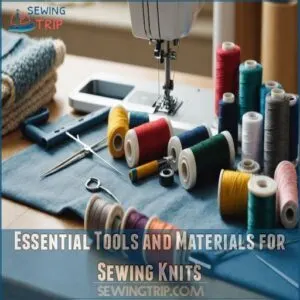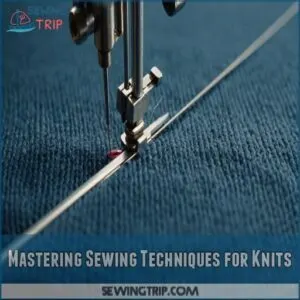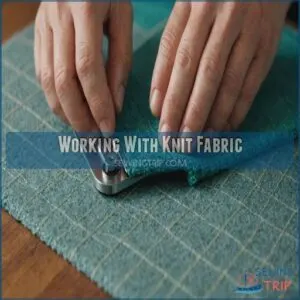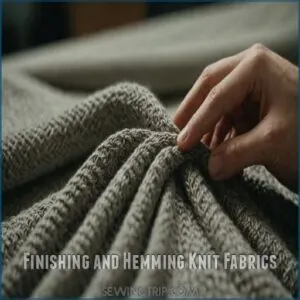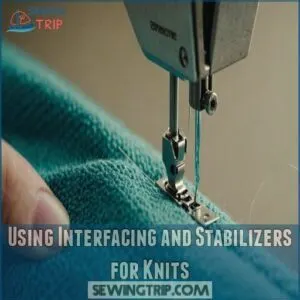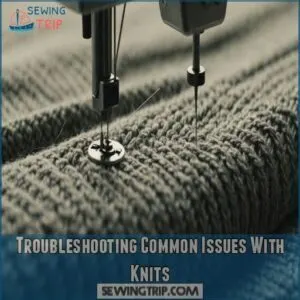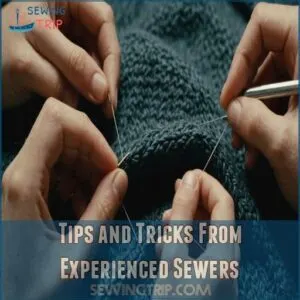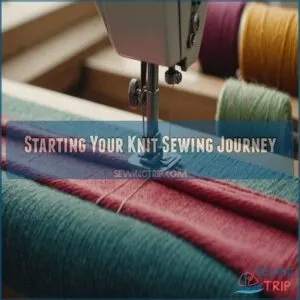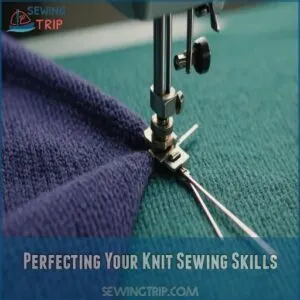This site is supported by our readers. We may earn a commission, at no cost to you, if you purchase through links.
 When sewing knits, you need the best techniques for success.
When sewing knits, you need the best techniques for success.
First, relax—your fabric’s stretchy, but you’ve got this!
Use a stretch or jersey needle to prevent skipped stitches.
Keep your walking foot handy, as it feeds fabric evenly, avoiding nasty puckers.
Try a slight zig-zag stitch; it’ll give seams the flexibility they need.
Don’t pull the fabric; let the machine do its magic.
Thread choice matters too—polyester’s your friend here.
For that professional touch, consider a serger if you’re serious about sewing knits.
Ready for more fabric adventures? Dive deeper into your knit journey and see how pros tackle it!
Table Of Contents
- Key Takeaways
- Choosing The Right Knit Fabric
- Essential Tools and Materials for Sewing Knits
- Mastering Sewing Techniques for Knits
- Working With Knit Fabric
- Finishing and Hemming Knit Fabrics
- Using Interfacing and Stabilizers for Knits
- Troubleshooting Common Issues With Knits
- Tips and Tricks From Experienced Sewers
- Starting Your Knit Sewing Journey
- Perfecting Your Knit Sewing Skills
- Frequently Asked Questions (FAQs)
- Conclusion
Key Takeaways
- Use a stretch or jersey needle to prevent skipped stitches and ensure smoother sewing on knits.
- Adjust your machine settings to use a zigzag or stretch stitch for flexibility and strength in seams.
- Consider using a walking foot or rotary cutter with pattern weights to avoid fabric stretching and distortion during cutting.
- A serger can add a professional finish to seams, preventing fraying while maintaining the fabric’s stretchiness.
Choosing The Right Knit Fabric
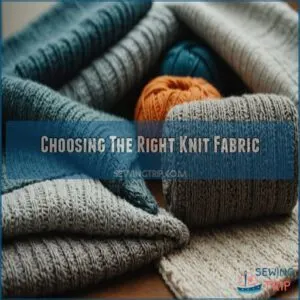
Choosing the right knit fabric is key to a successful project, so let’s get you started!
We’ll explore fiber content, weight, and stretch to help you find the perfect material for your next creation.
Understanding Fiber Content and Weight
Ever stared at a fabric roll, wondering if it’s the one?
Understanding fiber content and weight is key—like choosing a dance partner for smooth moves.
Fibers affect the knit’s stretchiness, while weight dictates drape and texture.
Master these aspects to make sure your knit fabric’s graceful flow and ideal stretch.
Remember, picking right transforms sewing from chore to charm!
Selecting The Right Knit Fabric for Your Project
As you wrap your head around fiber content and weight, selecting the right knit fabric becomes an adventure.
Think about the fabric drape and knit weight.
A lightweight jersey for tops or a cozy fleece for jackets?
It’s like matchmaking for your projects.
Consider fiber blend and stretch recovery to make sure the perfect project fit, blending comfort with style.
Considering Stretch Percentage and Recovery
Choosing knit fabric involves more than a quick feel; it’s a dance between stretch percentage and recovery rate.
Picture your favorite t-shirt lounging at home—its comfort comes from just right knit fabric stretch and recovery.
For sewing techniques, especially with spandex, focus on how the fabric returns to shape, ensuring garment fit and a happy wardrobe.
Essential Tools and Materials for Sewing Knits
You might feel like you’re gearing up for a space mission, but trust me, having the right tools makes sewing knits a breeze.
From special needles and stretchy threads to a trusty serger, these essentials will transform your stretchy fabric projects, making them possible but enjoyable!
Using Patterns Specifically Designed for Knit Fabrics
Patterns designed for knit fabrics are like secret weapons. They consider negative ease and stretch allowance, making your project fit just right.
To get the best results, it’s important to determine your pattern size accurately by consulting the size chart provided with the chosen sewing pattern and taking precise body measurements.
Skip the headache of pattern adjustments by choosing these gems. They guide you in selecting the right size while embracing the quirks of sewing with knits.
So, get those knit sewing patterns and start crafting away!
The Importance of a Serger/Overlock Machine
Ever felt like your knits don’t have that professional finish you’re aiming for?
Enter the serger/overlock machine.
It’s perfect for:
- Neat seams that lay flat.
- Preventing fraying with its clean edges.
- Creating durable seams for stretchy fabrics.
- Adding that polished touch to your pieces.
It’s a game-changer for mastering knit fabric sewing techniques!
Choosing The Right Needles and Threads for Knits
Okay, so you’ve mastered the serger! Now, let’s talk needles and thread.
When sewing stretchy fabrics, it’s essential to prevent damage and enhance elasticity by using a stabilizing knit fabric technique. For sewing stretchy fabric, use ballpoint or stretch needles; they glide through knit fabric without snagging.
Choose a stretchy thread like polyester or wooly nylon.
Consider your fabric weight—lighter knits need finer needles and thread.
These simple knit sewing tips will make a world of difference!
Remember, the right tools are half the battle when sewing with knits.
Mastering Sewing Techniques for Knits
When you’re ready to tackle knit fabrics, start by pre-washing to avoid any surprises later.
Use stitches like the zigzag and tweak your machine settings, so your garments don’t stretch in unexpected ways.
Pre-Washing and Cutting Knit Fabrics
You’ve gathered your tools, now let’s tackle pre-washing and cutting knit fabrics.
Pre-washing prevents unexpected shrinkage surprises, and washing them in cold or lukewarm water is key to preserving fabric stability.
Pay attention to the fabric grain when cutting.
Use rotary cutters and pattern weights to avoid stretching while cutting layers of knit fabric. This helps maintain your fabric’s shape and saves headaches.
Stay ahead with these techniques!
- Pre-washing: Prevents shrinkage.
- Fabric Grain: Cut with care.
- Rotary Cutters: Maintain accuracy.
- Pattern Weights: Prevent distortion.
Using Special Stitches and Adjusting Machine Settings
Tackling those pesky knit projects? Get into your sewing machine’s settings!
Adjust the stitch length and tension control to suit your stretchy fabric.
Use a jersey needle for better results and reduce foot pressure to prevent puckering.
Try different zigzag settings or a straight stretch stitch.
Trust me, with these tweaks, you’ll sew knits like a pro!
Employing a Slight Zig-Zag Stitch and Stretching The Fabric
A slight zig-zag stitch works wonders for sewing knits, giving you both flexibility and strength.
Imagine it as your stitch’s personal yoga routine, ensuring fabric stretch control while avoiding seam wobble.
Stretch the fabric as you sew, and you’ll perfect your stitch.
Pay attention to tension adjustments to keep things smooth and avoid any puckering disasters.
Working With Knit Fabric
When working with knit fabric, you want your cuts to be as smooth as your morning coffee.
Using a rotary cutter and pattern weights will help prevent stretching and distortion, ensuring each pattern piece fits just right.
Preventing Stretching and Distortion During Cutting
To minimize distortion when working with knits, consider using tutorials scuba fabric techniques Understanding Scuba Fabric Properties such as smoothness, resilience, and flexibility to guide your cutting decisions. While mastering sewing techniques, there’s a tricky spot: cutting knits without stretching or distortion.
To keep your fabric in shape:
- Fabric handling: Work on a flat surface.
- Cutting tools: Sharp scissors are your best friend.
- Pattern placement: Align pieces with the grainline.
- Measuring techniques: Double-check your measures to guarantee accuracy.
These steps help maintain knit fabric’s integrity.
Using Rotary Cutters and Pattern Weights for Accuracy
Now that you’ve mastered preventing stretches, let’s talk about accuracy!
Use a rotary cutter for smooth, even cuts.
Pattern weights keep your fabric flat, preventing shifting.
Remember rotary cutter safety—sharp blades need respect!
Different weights offer varying levels of control; experiment to find your favorite.
With practice, you’ll achieve accurate measurements every time, making sewing with knits a breeze.
Cutting Each Pattern Piece Individually
You’re mastering rotary cutters and pattern weights, but let’s chat about cutting each pattern piece individually.
It might take a bit longer, but this extra step helps you nail that pattern accuracy.
You’ll sidestep fabric slippage and minimize waste like a pro.
Plus, you’ll avoid stretching, and honestly, who doesn’t love sewing knit fabric with finesse?
Finishing and Hemming Knit Fabrics
Perfecting the finish and hem on your knit projects can set your work apart.
By mastering techniques like using a double needle and understanding when to leave raw edges or use a serger, you’ll create garments that look great but also wear well, too—plus, no wardrobe malfunctions!
Using a Double Needle for Hems and Preventing Bubbles
Ever wonder why your hems look wavy after sewing with knits?
Tackling hem bubbles is easier with a double needle, especially when paired with the right bobbin tension knit tools (bobbin tension knit).
Adjust the double needle and loosen the bobbin tension for a smoother finish.
This prevents bubbles and keeps your seams from unraveling.
One key to achieving this is by using a rolled hem foot, which guides fabric to roll neatly into place for a clean finish, especially when learning to sew a rolled hem on knit fabric. Trust me, this technique will keep your knit fabric hems looking professional and polished!
Backstitching Double-Needle Seams for Security
Securing your knit fabric seams is like giving a strong handshake.
After hemming with a double needle, backstitch your seams for added strength and to prevent unraveling.
Adjust your double-needle tension and bobbin tension to avoid puckering, keeping your stitch length uniform.
This guarantees your garments hold up over time, making backstitching a trusty safeguard in knit sewing techniques.
Leaving Raw Edges Unfinished or Using a Serger
After securing those seams, let’s talk edges.
With knit fabrics, you have a luxury: raw edges don’t unravel!
So, you might skip finishing them entirely.
But if you’re a stickler for polish, consider a serger.
This nifty machine whips through knits like a breeze, giving your projects that pro finish without breaking a sweat.
Using Interfacing and Stabilizers for Knits
When sewing knits, using interfacing and stabilizers can be a game changer, giving your garments the stability they need without losing stretch.
Think of it like adding spinach to a smoothie—barely noticeable, but it makes everything hold together a little better!
Adding Stability and Shape With Fusible Interfacing
Adding structure to your knit projects is easier than you think! Mastering fusible interfacing is key. Here’s how:
- Choose the right interfacing weight for your knit fabric.
- Precise interfacing placement is essential for a flawless finish.
- Experiment with types of interfacing to find your favorite.
- Proper interfacing application prevents puckering. You’ll be amazed at the results!
Using Knit Stay Tape for Necklines and Shoulder Seams
Ever found a neckline stretching out like a tired rubber band?
Using knit stay tape can save the day, keeping necklines and shoulder seams stable yet flexible.
It’s a game changer in your sewing toolkit, ensuring your knit fabric holds its shape.
Opt for alternatives, but nothing beats the reliability and ease of tape application!
Choosing The Right Closures for Knit Garments
Choosing the right closures can make or break your knit garment.
Snaps vs. buttons, you ask? Snaps offer a sleek touch for stretchy fabrics. To make sure you have a smooth sewing experience, use techniques like how to stabilize stretchy fabric when working with delicate or super stretchy materials. Don’t overlook decorative closures for a stylish twist. Remember, using interfacing and stabilizers makes closures sit pretty!
- Snaps vs. Buttons
- Zipper Alternatives
- Decorative Closures
Troubleshooting Common Issues With Knits
Mastering knits can feel like wrestling with an octopus, with stretching dilemmas and fabric slippage ready to challenge your patience.
But don’t worry—by using the right pins and adjusting your machine settings, you’ll smooth out those pesky issues and sew happily ever after.
Dealing With Stretching and Distortion During Sewing
Using the best stitch for stretch fabric Understanding Stretch Stitches can help prevent distortion. Struggling with fabric stretching and distortion is common when sewing knits.
Relax! Techniques like tension control and grain alignment, such as using a zig-zag stitch technique, can save you from wonky seams.
Make sure you’re using stretch stitches and keep your knit fabric stable.
Adjusting your sewing technique helps maintain fabric stability, ensuring your creations look polished and professional.
Preventing Fabric Slippage and Using The Right Pins
Pins and slippage: a match made in knitting heaven—or not?
Choose ballpoint pins for delicate knits to avoid snags.
For heavyweight fabrics, try clips.
Always pin perpendicular to seams; it’s like having an extra hand when sewing those tricky edges.
Tired of slippage? A little spray starch can be your secret weapon against those sneaky, slippery fabrics.
Adjusting Machine Settings for Different Knit Fabrics
Mastering the right needle for your project is crucial, using a ballpoint needle for knit fabrics can make all the difference. Adjusting your sewing machine for knits is like tuning a guitar—perfecting tension, foot pressure, and stitch length sets the stage for harmony.
Use a zigzag or stretch stitch to let the fabric move freely.
Needle size and thread type matter too, like picking the right band members.
Get these settings right, and your knit project will sing!
Tips and Tricks From Experienced Sewers
Ready to conquer those stretchy fabrics?
Let’s get you sewing like a pro with these insider tips and tricks from experienced knit sewers – you’ll be amazed at how easy it can be!
Sewing With Knits on a Home Sewing Machine
When starting to sew knits on your home sewing machine, don’t let those stretchy fabrics intimidate you, and make sure to set up your machine with a ballpoint or stretch needle to prevent snags and holes.
Use a stretch stitch like a zigzag to let the knit fabric stretch naturally, and mind the sewing machine setup to handle the fabric smoothly.
- Check machine settings for stretch compatibility.
- Choose the right thread for flexibility.
- Practice hemming techniques for neat finishes.
Using a Jersey or Stretch Needle for Knits
So you’ve mastered basic sewing techniques and are now ready to move on to more challenging projects. So you’ve tackled the basics on your sewing machine.
Switching to a jersey or stretch needle can be a game-changer.
These needles glide through knit fabrics like butter, preventing dreaded snags and skipped stitches.
They’re specifically designed for stretchy fabrics, ensuring smoother seams and less frustration.
It’s like giving your sewing machine the right tools for the job!
Changing Machine Stitch and Thread for Knits
Ready to level up your knit sewing game?
After selecting the right needle, adjust your machine’s stitch settings.
Opt for a zigzag stitch to handle knit fabric’s flexibility.
Don’t forget to tweak the thread tension and choose a compatible bobbin thread.
This guarantees your stitches stretch without snapping, letting you conquer even the trickiest fabrics.
Starting Your Knit Sewing Journey
You’re about to begin an exciting adventure with knit fabrics, where simple patterns are your new best friend.
Experiment with projects and gather inspiration from fellow sewing enthusiasts to fuel your creativity.
Choosing Simple Patterns or Sewing Without a Pattern
From veteran tips to starting your knit journey, embracing simple patterns or sewing without one is a fantastic leap.
Imagine crafting easy knit garments with just fabric drape, a trusty sewing machine, and your creative flair.
Beginner-friendly patterns and no-pattern projects give you the freedom to play and master the art of knit fabric sewing, one stitch at a time.
Experimenting With Different Knit Fabric Projects
Explore knit fabric projects and enjoy the thrill of creating unique knit creations.
Experimentation is your playground; try your hand at a t-shirt, or perhaps a cozy beanie.
Explore the right tools and supplies for your knit fabric needs at sewing knit fabric products.
You’ll quickly find that creative knit sewing presents exciting knit fabric challenges, transforming ideas into reality.
Each project offers knit fabric inspiration and helps build your knit sewing confidence.
Seeking Inspiration From Other Sewing Enthusiasts
Before you start, explore the amazing world of online sewing communities!
Find inspiration on inspirational blogs and in online forums.
You’ll discover tons of knit fabric projects and shared patterns.
Don’t be shy; ask questions and share your own sewing tips!
Seeing others’ creations—and their struggles—will boost your confidence.
You’ll quickly find yourself mastering knit sewing techniques and sewing knit garments like a pro.
Perfecting Your Knit Sewing Skills
You’re ready to take your knit sewing to the next level by practicing with scrap fabric and perfecting your machine settings.
Pressing seams can add a professional touch, making your projects look polished and well-crafted.
Practicing With Scrap Fabric and Testing Settings
Think of scrap fabric as your trusty sidekick in sewing adventures.
Using a knit sewing machine can also help you practice testing stitch tension, understanding fabric drape, and experimenting with needles.
Adjust foot pressure and assess fabric recovery to perfect your technique.
Don’t just leap into projects; these scraps help you master sewing with knits, setting you up for fabulous knit garments.
Pressing Seams and Adding a Professional
Already familiar with your scrap materials? Fantastic! Now, let’s upgrade those seams to pro level.
Grab your pressing tools and set the steam settings just right.
Apply gentle pressure with your iron, smoothing out those knit fabric ripples.
Master pressing techniques for that polished finish.
Your knit sewing techniques will soon scream "professional"! It’s like magic, only steamier.
Frequently Asked Questions (FAQs)
What is the best way to sew knits?
Sewing knits with confidence!
Use a serger for smooth edges.
A stretch needle to avoid snags.
Zigzag stitches for flexibility.
Remember, practice makes perfect, so don’t sweat the small stuff—enjoy the process!
What is the best way to sew knitted pieces together?
Remember that disastrous first attempt at a knit dress?
Use a ballpoint needle, a walking foot, and a stretchy stitch to sew knit pieces together smoothly.
It’ll make all the difference!
What is the best stitch for knit?
When you’re sewing knits, use a zigzag stitch or a "lightning bolt" stitch.
These stitches let the fabric stretch without popping seams.
It’s like giving your clothes the flexibility of a yoga master!
How to keep knits from stretching when sewing?
Prevent knits from stretching by using Wonder Clips instead of pins.
A rotary cutter helps with precision.
Sew with a stretch stitch.
Also, adjust your machine’s tension and avoid pulling the fabric while sewing.
How to prevent knits from curling edges?
You can stop knits from curling by ironing with spray starch, using a stabilizing stitch like a zigzag near edges, or applying fusible interfacing.
This keeps those frustrating curly edges in check, ensuring smoother sewing.
What are common mistakes in knit sewing?
Skipping the right needle and thread types with knits is like trying to bake without measuring—nothing goes as planned.
Avoid pulling fabric while sewing, and use a serger for seams that won’t unravel.
How to sew knits without stretching them?
Make sure you pre-wash your fabric.
Use a ballpoint needle and sew with a zigzag stitch.
Keep your hands close to the needle for control and avoid stretching the fabric.
A serger helps but isn’t necessary.
Which sewing machine settings are best for knits?
Dial down the tension a bit, set a longer stitch length, and use a zigzag or stretch stitch.
A ballpoint needle works wonders, and slightly reduce foot pressure to glide over those stretchy knit fabrics smoothly!
Can I sew knits without a serger?
Did you know 90% of knitters avoid sergers? You can totally sew knits without one. Use a stretch stitch and ballpoint needle; it’s easier than you think! Practice makes perfect.
Conclusion
Oddly enough, sewing knits can be as unpredictable as a cat deciding it loves bath time.
But with the best techniques for sewing knits up your sleeve, you’re ready to conquer any stretchy fabric that crosses your path.
Remember, it’s about embracing the stretch, choosing the right tools, and trusting your machine.
Go ahead and experiment—each project is a lesson in finesse.
Before you know it, you’ll be whipping up knit masterpieces with the ease of a seasoned pro.

